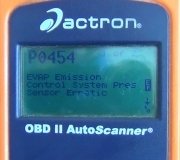Hi good morning,
So you are getting both codes at the same time? Usually I would expect to see one or the other so that interesting to me. Anyway, the P0455 is the more important one to deal with. Let me know what steps you have take so far. For instance have you inspected the fuel cap to see if it is sealing properly. That is the number one cause for these types of codes. But there are a few other possibilities if that is not the problem.
Typically what I do is run a "Smoke Test" on the system where I plug a smoke machine into one of the lines in the system and watch to see where the smoke gets let out! Its by far the easiest way to determine where the leak is.
As far as running new lines, you could do that if the prospect of lowering the tank is not in the cards for you. But in my experience, the lines are usually not the problem, most times I find that the plastic fittings dry rot, get brittle and crack. If you do find that the lines are the issue, make certain that the hose you use is rated to use on fuel systems or else it will degrade over a period of time.
Also I wouldn't recommend the flex seal for a fix.
Lets start with what you have done so far to diagnose your problem.
SPONSORED LINKS
Wednesday, December 2nd, 2020 AT 9:06 AM




